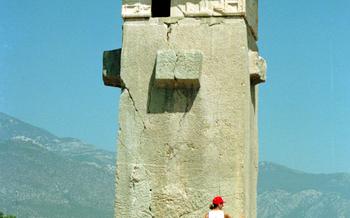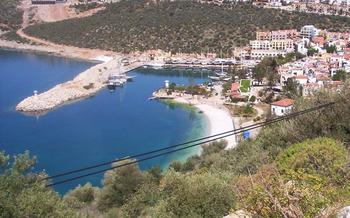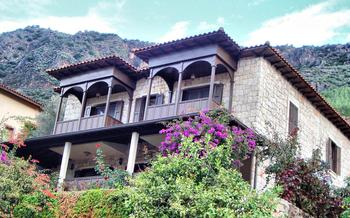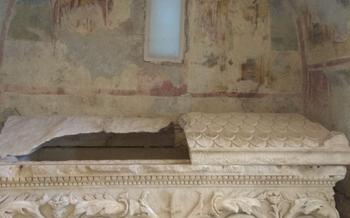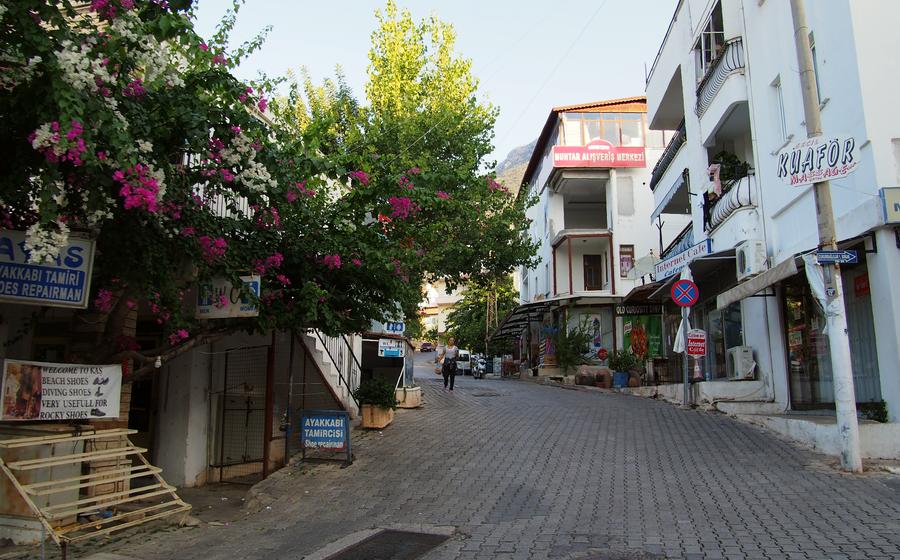
Xanthos Ancient City
- Historical Significance
- Well-Preserved Ruins
- Xanthos Theater: A Stage of Ancient Performances
- Agora Market
- Acropolis and City Walls
- Rock-Cut Tombs: A Window into Lycian Burial Customs
- Harpy Monument: A Mysterious Masterpiece
- Inscriptions and Stelae: Unveiling the Voices of Xanthos
- Xanthos Museum: A Treasure Trove of Lycian History
- Guided Tours
- Best Time to Visit
- Getting There
- What to Bring
- Insider Tip:
Historical Significance
Xanthos, an ancient city located in the picturesque region of Kaş, Turkey, holds immense historical significance as a prominent Lycian city-state. The Lycians, an enigmatic civilization that flourished in ancient Anatolia, played a pivotal role in the region's development. Their maritime prowess and strategic location enabled them to establish a flourishing trade network, spanning from the Mediterranean Sea to the far reaches of the ancient world. Xanthos served as a crucial hub in this network, facilitating the exchange of goods, ideas, and cultures.
The city's strategic position also made it a coveted prize for various empires throughout history. The Persians, Greeks, and Romans all sought to control this prosperous city, leaving their mark on its architectural landscape and cultural heritage. Xanthos's endurance as a significant urban center for over two millennia is a testament to its enduring legacy and the ingenuity of its inhabitants.
Well-Preserved Ruins
Xanthos boasts an impressive state of preservation, allowing visitors to witness the grandeur of the ancient city. Among the well-preserved structures, the theater stands out as a testament to the city's cultural significance. With its remarkably intact seating tiers and stage, the theater provides a breathtaking glimpse into the world of ancient performances and gatherings.
The agora, once the bustling heart of Xanthos, is another marvel of preservation. The market square, lined with shops, temples, and public buildings, retains its original layout, offering a tangible sense of the vibrant commercial and social activities that took place here.
The acropolis, perched atop a hill, offers a commanding view of the surrounding landscape. The city walls, with their formidable fortifications, provide a glimpse into Xanthos's defensive prowess. These well-preserved ruins, combined with ongoing restoration efforts, make Xanthos a living testament to the enduring legacy of the Lycian civilization.
Xanthos Theater: A Stage of Ancient Performances
The Xanthos Theater, a marvel of ancient engineering, stands as a testament to the Lycians' passion for the arts and entertainment. Constructed in the 4th century BC, this impressive structure boasts a seating capacity of over 5,000 spectators, making it one of the largest theaters in ancient Lycia. The theater's remarkable acoustics ensure that even the faintest whisper from the stage can be heard in the farthest rows.
In its heyday, the theater hosted a variety of performances, including plays, musical concerts, and even gladiator fights. The stage, adorned with intricate carvings and sculptures, provided a dynamic backdrop for the actors and performers. The theater's design also allowed for excellent views of the surrounding landscape, creating a truly immersive experience for the audience.
One of the most fascinating aspects of the Xanthos Theater is its connection to the Lycian's unique burial customs. During the Roman period, the theater was also used as a necropolis, with tombs built into the seating rows. This practice reflects the Lycians' belief in the afterlife and their desire to be close to their loved ones even after death.
Today, visitors to the Xanthos Theater can still marvel at its grandeur and imagine the vibrant performances that once took place on its stage. Whether you're a history buff, a theater enthusiast, or simply someone who appreciates ancient architecture, a visit to the Xanthos Theater promises an unforgettable experience.
Agora Market
The agora, or marketplace, was the bustling heart of ancient Xanthos, serving as a vibrant hub for trade, social gatherings, and political discussions. Located at the center of the city, the agora was a large, open square surrounded by colonnaded stoas, or covered walkways. These stoas housed shops, workshops, and stalls where merchants sold a variety of goods, including textiles, pottery, jewelry, and agricultural products.
The agora was not merely a commercial center but also a significant public space where citizens gathered to discuss important issues, exchange news, and participate in civic ceremonies. It was here that the city's assembly met to make decisions and enact laws. The agora also served as a venue for religious festivals and celebrations, with altars and temples dedicated to various deities located within the square.
The vibrant atmosphere of the agora was a testament to the economic prosperity and cultural vitality of Xanthos. The air was filled with the sounds of haggling merchants, the laughter of friends, and the speeches of politicians. The agora was a place where people from all walks of life came together to interact, trade, and shape the destiny of their city.
Acropolis and City Walls
The acropolis, the highest point of Xanthos, holds great significance as the center of the ancient city's religious and political life. Within the acropolis, visitors can explore the ruins of temples dedicated to various deities, including Apollo and Leto. The city walls, which once encircled and protected Xanthos, are a testament to the city's strategic importance. Constructed with massive stone blocks, these walls feature impressive towers and gates, providing a glimpse into the city's defensive capabilities.
Ascending to the acropolis rewards visitors with breathtaking panoramic views of the surrounding landscape. From this vantage point, one can admire the sprawling ruins of Xanthos, the meandering Xanthos River, and the distant peaks of the Taurus Mountains. The city walls, with their imposing presence, add to the grandeur of the scenery, creating a sense of awe and wonder.
Rock-Cut Tombs: A Window into Lycian Burial Customs
The rock-cut tombs of Xanthos stand as a testament to the Lycians' unique burial customs and artistic prowess. These elaborate tombs, carved directly into the rocky cliffs, showcase the Lycians' mastery of stonemasonry. The intricate carvings and inscriptions that adorn the tombs provide valuable insights into their beliefs and traditions.
One of the most striking features of the Xanthos tombs is their variety. Some tombs are simple chambers, while others are elaborate structures with multiple rooms and intricate facades. The tombs are also adorned with a wide range of carvings, including depictions of mythological scenes, animals, and human figures.
The Lycians believed in an afterlife, and the tombs were designed to provide a comfortable and well-appointed resting place for the deceased. The tombs often contained grave goods, such as jewelry, pottery, and weapons, to accompany the deceased on their journey to the next world.
Exploring the rock-cut tombs of Xanthos is a fascinating and thought-provoking experience. These tombs offer a glimpse into the lives and beliefs of the ancient Lycians and provide a unique perspective on their culture and society.
Harpy Monument: A Mysterious Masterpiece
Amidst the ruins of Xanthos, one particular monument stands out for its enigmatic beauty and intriguing history—the Harpy Monument. Discovered in 1838 by Sir Charles Fellows, this remarkable artifact is now housed in the British Museum in London. The monument, dating back to the 5th century BC, features a series of intricately carved winged figures known as harpies. These mythical creatures, with their human heads and bird-like bodies, are depicted in dynamic poses, seemingly caught in a moment of flight.
The exact significance of the Harpy Monument remains a subject of debate among scholars. Some believe it served as a funerary monument, while others suggest it was a votive offering to a deity. The intricate carvings and inscriptions on the monument provide valuable insights into Lycian mythology and religious beliefs. The Harpy Monument stands as a testament to the artistic prowess and cultural richness of the ancient Lycians, leaving visitors in awe of its enduring legacy.
Inscriptions and Stelae: Unveiling the Voices of Xanthos
Xanthos is not only a treasure trove of architectural wonders but also a repository of written records that provide invaluable insights into the Lycian civilization. Numerous inscriptions and stelae, carved in stone, have been discovered within the city's ruins, offering a glimpse into the lives, beliefs, and history of the ancient Lycians.
These inscriptions range from funerary inscriptions commemorating the deceased to decrees and treaties that shed light on the political and legal structures of Xanthos. Funerary inscriptions, often accompanied by intricate carvings and iconography, provide glimpses into the personal lives and social status of the individuals they honor.
Official decrees and treaties, on the other hand, document important events, alliances, and agreements between Xanthos and other Lycian city-states. They offer valuable insights into the political landscape and diplomatic relations of the region.
One of the most significant inscriptions found in Xanthos is the Xanthos Stele, also known as the Lycian Stele. Discovered in 1840, it contains a trilingual inscription in Lycian, Greek, and Aramaic, providing a key to deciphering the Lycian language. This stele has played a crucial role in understanding the history and culture of the Lycians.
The inscriptions and stelae of Xanthos stand as testaments to the rich cultural heritage of the ancient Lycians. They offer a unique opportunity to delve into the history, politics, and social customs of this remarkable civilization, providing a voice to those who once inhabited this vibrant city.
Xanthos Museum: A Treasure Trove of Lycian History
The Xanthos Museum stands as a testament to the rich cultural heritage of the Lycian civilization. Nestled in the heart of Kaş, this museum houses an impressive collection of artifacts unearthed from the ancient city of Xanthos. As you step inside, you'll be greeted by a captivating array of sculptures, pottery, jewelry, and inscriptions that tell the story of this once-thriving metropolis.
Among the museum's highlights are the intricate sculptures that once adorned the city's temples and tombs. These masterpieces showcase the Lycians' exceptional craftsmanship and artistic prowess, depicting scenes from mythology, history, and everyday life. The museum also boasts a remarkable collection of pottery, ranging from utilitarian vessels to elaborately decorated vases, offering a glimpse into the daily lives of the Lycians.
Don't miss the exquisite jewelry on display, showcasing the Lycians' mastery of metalworking. From delicate necklaces and earrings to intricate brooches and bracelets, these pieces reflect the Lycians' love of adornment and their attention to detail.
The Xanthos Museum is not just a repository of artifacts; it's a gateway to understanding the Lycian civilization. Through its immersive exhibits and informative displays, the museum brings the past to life, allowing visitors to connect with the people who once called Xanthos home.
Guided Tours
Exploring Xanthos with a knowledgeable guide is an enriching experience that enhances your understanding of the site's history and significance. Guided tours offer several benefits:
-
Expert Insights: Guides provide in-depth information about Xanthos's past, including historical context, architectural details, and cultural practices. They can answer your questions and clarify any doubts you may have.
-
Personalized Experience: With a private tour, you can tailor the itinerary to your interests and pace. The guide can focus on specific aspects of Xanthos that you find most compelling, ensuring a personalized and immersive experience.
-
Hidden Gems: Guides often know about hidden gems and lesser-known spots within Xanthos that you might miss if exploring independently. They can lead you to secluded ruins, panoramic viewpoints, or intriguing artifacts that you might otherwise overlook.
-
Cultural Context: A good guide will provide insights into the Lycian culture and way of life. They can explain the significance of the monuments, inscriptions, and traditions, helping you gain a deeper appreciation for Xanthos's cultural heritage.
-
Group Tours: Group tours offer a social and interactive experience, allowing you to share your discoveries with fellow history enthusiasts. Group tours are often led by experienced guides who ensure everyone has a meaningful and enjoyable experience.
Best Time to Visit
The beauty of Xanthos can be experienced throughout the year, but the best time to visit is during the shoulder seasons, from April to May and from September to October. During these months, the weather is pleasant, with warm days and cool nights, making it ideal for exploring the ancient city. The crowds are also smaller, allowing you to enjoy a more intimate experience.
While summer months offer longer daylight hours, the heat can be intense, especially during midday. If you choose to visit during this time, plan your visit accordingly, starting early in the morning or late in the afternoon to avoid the peak heat.
Winter months, from November to March, can be chilly and rainy, but the site is still accessible. The lack of crowds during this time provides a unique opportunity for a serene and contemplative visit.
Regardless of the time of year you choose to visit, be sure to pack comfortable shoes for walking on uneven surfaces and bring plenty of water, as there are limited food and beverage options available on-site.
Getting There
Reaching Xanthos is a relatively easy task, with various transportation options available. If you're a fan of road trips, renting a car is a great choice. From Antalya, the journey takes about an hour and a half, and the scenic route along the Mediterranean coast is a treat in itself. Alternatively, you can hop on a bus from Antalya or Fethiye, which takes approximately two hours. The buses are comfortable and offer a budget-friendly option. If you're coming from Kaş, the journey is even shorter, taking around 45 minutes by car or bus. No matter how you choose to travel, the roads are well-maintained, making the journey smooth and enjoyable.
What to Bring
When embarking on your journey to Xanthos, it is crucial to come prepared. Sturdy and comfortable footwear is paramount, as you will be traversing uneven terrain and navigating ancient cobblestones. Protect yourself from the relentless Mediterranean sun with a wide-brimmed hat and a generous application of sunscreen. Stay hydrated by carrying a reusable water bottle, as there are limited options for purchasing refreshments on-site. Consider packing a light snack to sustain your energy levels throughout your exploration. Although the site is generally well-maintained, wearing long pants or skirts is advisable to avoid any discomfort from overgrown vegetation or rough surfaces. For photography enthusiasts, a camera with a wide-angle lens is ideal for capturing the grandeur of the ruins and the panoramic vistas. Remember, while exploring Xanthos, it is essential to tread carefully, respecting the historical significance of the site and preserving its integrity for future generations.
Insider Tip:
For a truly unforgettable experience, visit Xanthos during the annual "Lycian Days" festival. This vibrant celebration showcases the rich cultural heritage of the region through traditional music, dance, and theatrical performances. Immerse yourself in the lively atmosphere as the ancient city comes alive with the sights, sounds, and flavors of Lycian culture. Don't miss the opportunity to witness the reenactment of ancient rituals and ceremonies, transporting you back in time to the era of the Lycians.
